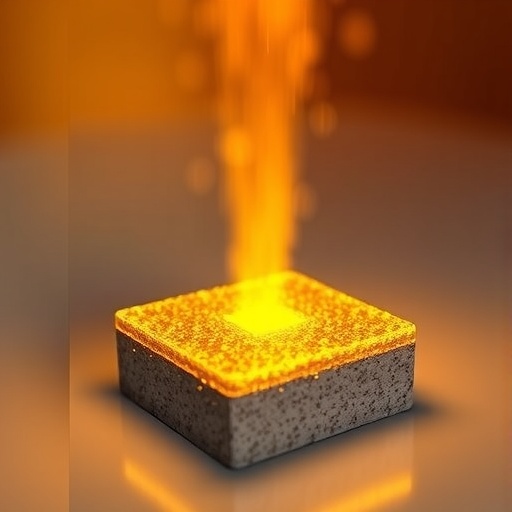Recent advancements in energy storage technologies have prompted researchers to explore innovative materials and methods to enhance the performance and efficiency of these systems. One particularly intriguing area of study focuses on the development of carbon-doped cementitious electrodes, a promising alternative for traditional energy storage solutions. In their latest publication, Shen, Zhao, and Deng shed light on how surface modifications to these electrodes can significantly improve their pseudocapacitive performance, making them suitable for various energy storage applications.
The introduction of carbon-doped cementitious materials represents a shift from conventional electrode materials, which often rely on metals or carbon alone. By integrating both carbon and cement-based components, researchers have harnessed the unique properties of each, resulting in an electrode solution that is not only cost-effective but also environmentally friendly. This dual composition allows for enhanced conductivity and surface area, critical features that contribute to superior energy storage capabilities.
Surface modifications play a pivotal role in optimizing the performance of these electrodes. By altering the surface characteristics of the carbon-doped cementitious electrodes, the researchers can significantly influence their electrochemical behavior. This study investigates various modification techniques aimed at improving charge transfer and ion conductivity within these materials. The results indicate that even subtle changes to the surface can have profound effects on performance, showcasing the importance of material engineering in the field of energy storage.
The fabrication process of the modified electrodes is meticulously detailed in the study. It involves a series of steps that ensure the homogeneous distribution of carbon within the cement matrix while enabling the achievement of desired surface properties. By employing various synthesis methods, the researchers have generated materials that not only meet technical specifications but also offer scalability for commercial applications. This approach emphasizes the importance of practical methodologies in research, ensuring that findings can transition smoothly from the laboratory to real-world applications.
Performance testing of the surface-modified carbon-doped electrodes reveals exciting potential for future energy storage systems. The pseudocapacitive performance, a crucial metric for evaluating energy storage materials, is shown to be significantly enhanced due to the surface modifications. By conducting extensive electrochemical evaluations, including cyclic voltammetry and impedance spectroscopy, the authors provide compelling evidence that their material outperforms traditional alternatives in various metrics, including charge-discharge cycles and energy density.
The implications of these findings extend beyond basic material science; they touch on various applications spanning renewable energy systems, electric vehicles, and portable electronic devices. As the world progresses toward a more sustainable energy future, the demand for efficient and reliable energy storage solutions continues to grow. The surface-modified carbon-doped cementitious electrodes present an attractive solution, addressing key challenges such as availability, environmental impact, and cost-effectiveness.
Furthermore, the study contributes to the understanding of the underlying mechanisms behind pseudocapacitance in these novel electrodes. Pseudocapacitance involves rapid electrochemical redox reactions, enabling high energy and power densities. By deepening the understanding of how surface properties affect these reactions, the researchers pave the way for the design of next-generation energy storage materials that leverage both ceramic and conductive components.
Another significant advantage of these electrodes is their mechanical stability. Unlike many traditional conductive materials, which may degrade over time or with repeated charge-discharge cycles, the robustness of cementitious matrices adds a layer of durability. This characteristic is vital for applications that necessitate long-term reliability, particularly in harsh environmental conditions that characterize many energy storage systems.
Moreover, the materials’ resistance to thermal degradation is a prominent feature that extends their usability in high-temperature environments. With increasing integration of energy storage systems in industrial applications, the ability to withstand elevated temperatures without losing performance quality is essential. This study presents a substantial leap forward in designing and engineering electrodes capable of navigating such challenges.
The researchers also highlight the environmental benefits of using carbon-doped cementitious materials. Traditional energy storage solutions often employ materials that have significant ecological footprints, both in terms of sourcing and production. Conversely, this new approach advocates for the use of more sustainable, greener materials, promoting a circular economy. This methodology not only aims to improve performance but also aims to reduce the overall impact of energy systems on the planet.
As energy storage technologies become increasingly vital to combating climate change and supporting renewable energy initiatives, innovations like those presented by Shen and colleagues provide a glimpse into a sustainable future. The research not only exemplifies the potential of interdisciplinary collaboration—melding chemistry, materials science, and engineering—but also emphasizes the necessity of innovative approaches in tackling contemporary issues in energy technology.
In summary, the development and analysis of surface-modified carbon-doped cementitious electrodes open new vistas in the realm of energy storage solutions. The intersection of material science and engineering principles showcased in this research exemplifies the critical role of innovation in addressing the global energy challenge. With ongoing research and development, such materials could ultimately play a key role in the transition toward efficient and sustainable energy systems worldwide.
In conclusion, the path forward for energy storage technology is bright, thanks to the groundbreaking work emerging in this field. As researchers continue to push the envelope, we can expect to see a transformation in how energy is stored, treated, and utilized. Surface-modified carbon-doped cementitious electrodes illuminate just one of the many exciting directions that future research may take, promising to enhance performance while simultaneously promoting sustainability and environmental responsibility.
Subject of Research: Energy storage systems using surface-modified carbon-doped cementitious electrodes.
Article Title: Surface-modified carbon-doped cementitious electrodes for energy storage systems: fabrication and pseudocapacitive performance.
Article References:
Shen, Y., Zhao, G., Deng, T. et al. Surface-modified carbon-doped cementitious electrodes for energy storage systems: fabrication and pseudocapacitive performance. Ionics (2025). https://doi.org/10.1007/s11581-025-06618-1
Image Credits: AI Generated
DOI: https://doi.org/10.1007/s11581-025-06618-1
Keywords: Energy Storage, Carbon-doped Cementitious Electrodes, Pseudocapacitance, Surface Modification, Sustainable Technologies.




